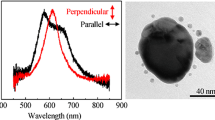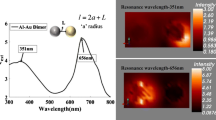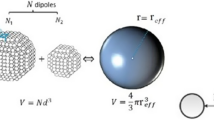Abstract
We present a detailed theoretical analysis of the Förster energy transfer process when a pair of molecules (donor and acceptor) is located nearby a cluster of two metallic nanospheres (dimer). We consider the case in which plasmonic resonances are within the overlap between the donor emission and acceptor absorption spectra, as well as the case that excludes such resonances from the aforementioned spectral overlap. Moreover, we explore the dependence of the Förster energy transfer rate on different dimer configurations (size and separation of nanospheres) and several dipole orientations of molecules. The dimer perturbs strongly the Förster energy transfer rate when plasmons are excited, donor dipole is oriented along the longitudinal axis of the dimer, and the radii of nanospheres and the sphere-gap distance are on the order of a few nanometers. In case of plasmonic excitation, the Förster energy transfer rate is degraded as the sphere-gap distance and size of the nanoparticles increase due to the dephasing of electronic motion arising from ohmic losses of metal. Also, we study the Förster efficiency influenced by the dimer, finding that the high efficiency region (delimited by the Förster radius curve) is reduced as a consequence of significant enhancement of the direct donor decay rate. Our study could impact applications that involve Förster energy transfer.







Similar content being viewed by others
References
Förster Th (1946) Energiewanderung und Fluoreszenz. Naturwissenschaften 33:166–175
Dexter DL (1953) A theory of sensitized luminescence in solids. J Chem Phys 21:836–850
Cooper GM, Hausman RE (2009) The cell: a molecular approach, 5th edn. ASM Press, Washington
Scholes GD (2003) Long-range resonance energy transfer in molecular systems. Annu Rev Phys Chem 54:57–87
Kagan CR, Murray CB, Nirmal M, Bawendi MG (1996) Electronic energy transfer in CdSe quantum dot solids. Phys Rev Lett 76:1517–1520
Selvin PR (2000) The renaissance of fluorescence resonance energy transfer. Nat Struct Biol 7:730–734
Mor GK, Basham J, Paulose M, Kim S, Varghese OK, Vaish A, Yoriya S, Grimes CA (2010) High-efficiency Förster resonance energy transfer in solid-state dye sensitized solar cells. Nano Lett 10:2387–2394
Purcell EM (1946) Spontaneous emission probabilities at radio frequencies. Phys Rev 69:681
Dung HT, Knöll L, Welsch D-G (2002) Intermolecular energy transfer in the presence of dispersing and absorbing media. Phys Rev A 65:043813
Pelton M (2015) Modified spontaneous emission in nanophotonic structures. Nat Photon 9:427–435
Colas des Francs G, Barthes J, Bouhelier A, Weeber JC, Dereux A, Cuche A, Girard C (2016) Plasmonic Purcell factor and coupling efficiency to surface plasmons. Implications for addressing and controlling optical nanosources. J Opt 18:094005
Gonzaga-Galeana JA, Zurita-Sánchez JR (2013) A revisitation of the Förster energy transfer near a metallic spherical nanoparticle: (1) efficiency enhancement or reduction? (2) the control of the Förster radius of the unbounded medium. (3) the impact of the local density of states. J Chem Phys 139:244302
Nordlander P, Oubre C, Prodan E, Li K, Stockman M (2004) Plasmon hybridization in nanoparticle dimers. Nano Lett 4:899–903
Faessler V, Hrelescu C, Lutich AA, Osinkina L, Mayilo S, Jäckel F, Feldmann J (2011) Accelerating fluorescence resonance energy transfer with plasmonic nanoresonators. Chem Phys Lett 508:67–70
Ghenuche P, Mivelle M, de Torres J, Moparthi SB, Rigneault H, Van Hulst NF, García-Parajó MF, Wenger J (2015) Matching nanoantenna field confinement to FRET distances enhances Förster energy transfer rates. Nano Lett 15:6193–6201
Bidault S, Devilez A, Ghenuche P, Stout B, Bonod N, Wenger J (2016) Competition between Förster resonance energy transfer and donor photodynamics in plasmonic dimer nanoantennas. ACS Photonics 3:895–903
de Torres J, Mivelle M, Moparthi SB, Rigneault H, Van Hulst NF, García-Parajó MF, Margeat E, Wenger J (2016) Plasmonic nanoantennas enable forbidden Förster dipole-dipole energy transfer and enhanced the FRET efficiency. Nano Lett 16:6222–6230
Ren J, Wu T, Yang B, Zhang X (2016) Simultaneously giant enhancement of Förster resonance energy transfer rate and efficiency based on plasmonic excitations. Phys Rev B 94:125416
Andrews DL (1989) A unified theory of radiative and radiationless molecular energy transfer. Chem Phys 135:195–201
Durach M, Rusina A, Klimov VI, Stockman MI (2008) Nanoplasmonic renormalization and enhancement of Coulomb interactions. New J Phys 10:105011
Wubs M, Vos WL (2016) Förster resonance energy transfer rate in any dielectric nanophotonic medium with weak dispersion. New J Phys 18:053037
Zurita-Sánchez JR, Tec-Chim AI (2014) Quasi-static potential created by an oscillating dipole in the vicinity of two dielectric spheres (dimer): inversion transformation method. J Opt 16:065002
Hövel H, Fritz S, Hilger A, Kreibig U, Vollmer M (1993) Width of cluster plasmon resonances: Bulk dielectric functions and chemical interface damping. Phys Rev B 48:18178– 18188
Palik ED (1998) Handbook of optical constants of solids vol. 4. Academic Press, San Diego
Klimov VV, Guzatov DV (2007) Optical properties of an atom in the presence of a two-nanosphere cluster. Quantum Electron 37:209–230
TermoFisher Scientific (2016) Fluorescence SpectraViewer. http://www.thermofisher.com/mx/es/home/life-science/cell-analysis/labeling-chemistry/fluorescence-spectraviewer.html, Accessed May 2016
Fluorophores.org (2016) Data of Fluorescent Dyes, Properties and Applications. http://www.fluorophores.tugraz.at/substance/490, Accessed May 2016
Acknowledgements
This work has been supported by SEP-CONACYT (Basic Science Grant CB2008/98449-F). JM-V thanks CONACYT for his scholarship (#625523).
Author information
Authors and Affiliations
Corresponding author
Electronic supplementary material
Below is the link to the electronic supplementary material.
Rights and permissions
About this article
Cite this article
Zurita-Sánchez, J.R., Méndez-Villanueva, J. Förster Energy Transfer in the Vicinity of Two Metallic Nanospheres (Dimer). Plasmonics 13, 873–883 (2018). https://doi.org/10.1007/s11468-017-0583-4
Received:
Accepted:
Published:
Issue Date:
DOI: https://doi.org/10.1007/s11468-017-0583-4




